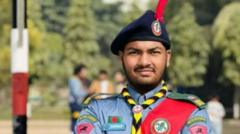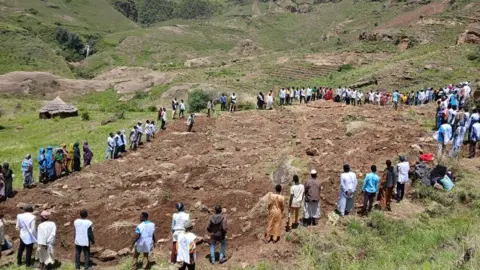The Bangladesh Air Force fighter jet F-7 plunged into the Milestone School and College in Dhaka, marking a catastrophic aviation disaster. Witness Ahnaf Bin Hasan, just 18, described the scene as an explosion of chaos, “like 30 or 40 thunderbolts falling from the sky,” as he watched the jet nosedive over him moments before it struck the building. Tragically, the accident happened at a time when many young students were preparing to be picked up or were enrolled in after-school programs. The crash has claimed the lives of 31 individuals, predominantly children under 12, a toll that has reshaped the community.
As flames engulfed the school, Ahnaf recounted the horrifying aftermath—children screaming, and confusion reigning as he instinctively rushed to help others. “It was so hot, but I threw the bag aside and ran to help,” he shared, recalling his efforts to assist a fellow student who had suffered severe burns. Eyewitness reports confirmed that the jet had crashed into an area of the school known for its children's classrooms, leading to an unimaginable scene of trauma and devastation.
Tragically, among the deceased was 11-year-old Wakia Firdous Nidhi, whose family faced the tragic burden of not only losing her but also enduring bureaucratic obstacles in reclaiming her body after identification. Her grieving uncle expressed the agony of waiting amid a complex series of demands for DNA testing, a process that added to their heartbreak.
Amid the suffering, instances of remarkable bravery emerged. Mahreen Chowdhury, a teacher, risked her life to help at least 20 students escape, only to succumb to her injuries days later—a reminder of the sacrifices made during the crisis. Meanwhile, community members who lost loved ones shared their harrowing experiences, including a parent who lost both children within a day, highlighting the profound grief that continues to resonate throughout Dhaka.
While authorities claim varying death tolls, the chaos has raised concerns about possible misinformation and unreported fatalities. Survivors and eyewitnesses, like Ahnaf, continue to struggle with the psychological impacts of the event, voicing fears that the trauma may haunt them indefinitely. “Every time I look outside, I feel like a fighter jet is coming at me,” he said, illustrating the haunting memories of the fateful day.
As the community mourns, the shadows of the crash linger, exposing the need for careful consideration of the safety of schools located near flight paths and the urgency of addressing the emotional fallout of this dark chapter in Bangladesh's history.
As flames engulfed the school, Ahnaf recounted the horrifying aftermath—children screaming, and confusion reigning as he instinctively rushed to help others. “It was so hot, but I threw the bag aside and ran to help,” he shared, recalling his efforts to assist a fellow student who had suffered severe burns. Eyewitness reports confirmed that the jet had crashed into an area of the school known for its children's classrooms, leading to an unimaginable scene of trauma and devastation.
Tragically, among the deceased was 11-year-old Wakia Firdous Nidhi, whose family faced the tragic burden of not only losing her but also enduring bureaucratic obstacles in reclaiming her body after identification. Her grieving uncle expressed the agony of waiting amid a complex series of demands for DNA testing, a process that added to their heartbreak.
Amid the suffering, instances of remarkable bravery emerged. Mahreen Chowdhury, a teacher, risked her life to help at least 20 students escape, only to succumb to her injuries days later—a reminder of the sacrifices made during the crisis. Meanwhile, community members who lost loved ones shared their harrowing experiences, including a parent who lost both children within a day, highlighting the profound grief that continues to resonate throughout Dhaka.
While authorities claim varying death tolls, the chaos has raised concerns about possible misinformation and unreported fatalities. Survivors and eyewitnesses, like Ahnaf, continue to struggle with the psychological impacts of the event, voicing fears that the trauma may haunt them indefinitely. “Every time I look outside, I feel like a fighter jet is coming at me,” he said, illustrating the haunting memories of the fateful day.
As the community mourns, the shadows of the crash linger, exposing the need for careful consideration of the safety of schools located near flight paths and the urgency of addressing the emotional fallout of this dark chapter in Bangladesh's history.



















